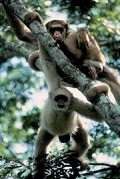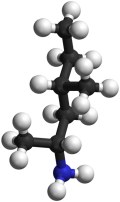| Scientific Name |
Common Name |
Category |
Population |
Threats to Survival |
| Abies beshanzuensis |
Baishan Fir |
Conifer |
5 mature individuals |
Agricultural expansion and fire |
| Actinote zikani |
|
butterfly |
Unknown, one population remaining |
Habitat degradation due to pressure from human populations |
| Aipysurus foliosquama |
Leaf scaled sea-snake |
sea-snake |
Unknown, two subpopulations remain |
Unknown – likely degradation of coral reef habitat |
| Amanipodagrion gilliesi |
Amani Flatwing |
butterfly |
<500 individuals est. |
Habitat degradation due to increasing population pressure and water pollution |
| Antilophia bokermanni |
Araripe Manakin |
bird |
779 individuals (est 2010) |
Habitat destruction due to expansion of agriculture and recreational facilities and water diversion |
| Antisolabis seychellensis |
Seychelles earwig |
earwig |
Unknown (declining) |
Invasive species and climate change |
| Aphanius transgrediens |
|
freshwater fish |
Unknown (declining) |
Competition and predation by Gambusia and road construction |
| Aproteles bulmerae |
Bulmer’s Fruit Bat |
bat |
150 individuals (est) |
Hunting and cave disturbance |
| Ardea insignis |
White bellied heron |
bird |
70-400 individuals |
Habitat destruction and degradation due to hydropower development |
| Ardeotis nigriceps |
Great Indian Bustard |
bird |
50 -249 mature individuals |
Habitat loss and modification due to agricultural development |
| Astrochelys yniphora |
Ploughshare tortoise / angonoka |
tortoise |
440-770 |
Illegal collection for international pet trade |
| Atelopus balios |
Rio pescado stubfoot toad |
toad |
Unknown (declining) |
Chytridiomycosis and habitat destruction due to logging and agricultural expansion |
| Aythya innotata |
Madagascar Pochard |
bird |
approximately 20 mature individuals |
Habitat degradation due to slash-and-burn agriculture, hunting, and fishing / introduced fish |
| Azurina eupalama |
Galapagos damsel fish |
pelagic fish |
Unknown (declining) |
Climate Change – oceanographic changes associated with the 1982 / 1983 El Nino are presumed to be responsible for the apparent disappearance of this species from the Galapagos |
| Bahaba taipingensis |
Giant yellow croaker |
pelagic fish |
Unknown (declining) |
Over-fishing, primarily due to value of swim-bladder for traditional medicine – cost per kilogram exceeded that of gold in 2001 |
| Batagur baska |
Common Batagur/ Four-toed terrapin |
turtle |
Unknown (declining) |
Illegal export and trade from Indonesia to China |
| Bazzania bhutanica |
|
liverwort |
Unknown (declining) |
Habitat degradation and destruction due to forest clearance, overgrazing and development |
| Beatragus hunteri |
Hirola |
antelope |
< 1000 individuals |
Habitat loss and degradation, competition with livestock, poaching |
| Bombus franklini |
Franklin’s Bumble Bee |
bee |
Unknown (declining) |
Disease from commercially bred bumblebees and habitat destruction and degradation |
| Brachyteles hypoxanthus |
Northern muriqui |
primate |
< 1,000 individuals |
Habitat loss and fragmentation due to large-scale deforestation and selective logging |
| Bradypus pygmaeus |
Pygmy sloth |
sloth |
<500 individuals |
Habitat loss due to illegal logging of mangrove forests for firewood and construction and hunting of the sloths |
| Callitriche pulchra |
|
freshwater plant |
Unknown (declining) |
Exploitation of the species’ habitat by stock, and modification of the pool by local people |
| Calumma tarzan |
Tarzan’s chameleon |
chameleon |
Unknown |
Habitat destruction for agriculture |
| Cavia intermedia |
Santa Catarina’s guinea pig |
guinea pig |
40-60 individuals |
Habitat disturbance and possible hunting; small population effects |
| Cercopithecus roloway |
Roloway Guenon |
primate |
Unknown |
hunting for consumption as bushmeat, and habitat loss |
| Coleura seychellensis |
Seychelles sheath-tailed bat |
bat |
<100 mature individuals (est 2008) |
Habitat degradation and predation by invasive species |
| Cryptomyces maximus |
|
fungus |
Unknown (declining) |
Limited availability of habitat |
| Cryptotis nelsoni |
Nelson’s small-eared shrew |
shrew |
Unknown (declining) |
habitat loss due to logging cattle grazing, fire and agriculture |
| Cyclura collei |
Jamaican iguana |
iguana |
Unknown (declining) |
Predation by introduced species and habitat destruction |
| Dendrophylax fawcettii |
Cayman islands ghost orchid |
orchid |
Unknown (declining) |
Habitat destruction due to infrastructure development |
| Dicerorhinus sumatrensis |
Sumatran rhino |
rhino |
<250 individuals |
Hunting for horn -used in traditional medicine |
| Diomedea amsterdamensis |
Amsterdam Island albatross |
bird |
100 mature individuals |
Disease and incidental capture in long-line fishing operations |
| Diospyros katendei |
|
tree |
20 individuals, one population |
High pressure from communities for agricultural activity, illegal tree felling, habitat degradation due to alluvial gold digging and small population |
| Dipterocarpus lamellatus |
|
dipterocarp (tree) |
12 individuals |
Habitat loss and degradation due to logging of lowland forest and creation of industrial plantations |
| Discoglossus nigriventer |
Hula painted frog |
frog |
Unknown (recent rediscovery in 2011) |
Predation by birds and range restriction due to habitat destruction |
| Discorea strydomiana |
Wild Yam |
yam |
200 individuals |
Collection for medicinal use |
| Dombeya mauritiana |
|
flowering plant |
Unknown (declining) |
Habitat degradation and destruction due to encroachment by alien invasive plant species and cannabis cultivation |
| Elaeocarpus bojeri |
|
flowering plant |
<10 individuals |
Small population and degraded habitat |
| Eleutherodactylus glandulifer |
La Hotte Glanded Frog |
frog |
Unknown (declining) |
Habitat destruction due to charcoal production and slash-and-burn agriculture |
| Eleutherodactylus thorectes |
Macaya Breast-spot frog |
frog |
Unknown |
Habitat destruction due to charcoal production and slash-and-burn agriculture |
| Eriosyce chilensis |
Chilenito |
cactus |
<500 individuals |
Collection of flowering individuals |
| Erythrina schliebenii |
coral tree |
flowering tree |
< 50 individuals |
Limited habitat and small population size increasing vulnerability to stochastic events |
| Euphorbia tanaensis |
|
semi-deciduous tree |
4 mature individuals |
Illegal logging and habitat degradation due to agricultural expansion and infrastructure development |
| Eurynorhynchus pygmeus |
Spoon-billed sandpiper |
bird |
< 100 breeding pairs |
Trapping on wintering grounds and land reclamation. |
| Ficus katendei |
|
tree (ficus) |
< 50 mature individuals |
Agricultural activity, illegal tree felling and habitat degradation due to alluvial gold digging |
| Geronticus eremita |
Northern Bald Ibis |
bird |
200-249 mature individuals |
Habitat degradation and destruction, and hunting |
| Gigasiphon macrosiphon |
|
flowering tree |
33 mature individuals |
Timber extraction and habitat degradation due to agricultural encroachment and development, seed predation by wild pigs |
| Gocea ohridana |
|
mollusc |
Unknown (declining) |
Habitat degradation due to increasing pollution levels, off-take of water and sedimentation events |
| Heleophryne rosei |
Table Mountain ghost frog |
frog |
Unknown (declining) |
Habitat degradation due to invasive plants and water abstraction |
| Hemicycla paeteliana |
|
mollusc |
Unknown (declining) |
Habitat destruction due to overgrazing and trampling by goats and tourists |
| Heteromirafra sidamoensis |
Liben Lark |
bird |
90- 256 individuals |
Habitat loss and degradation due to agricultural expansion, over-grazing and fire suppression |
| Hibiscadelphus woodii |
|
hibiscus |
Unknown |
Habitat degradation due to feral ungulates and invasive introduced plant species |
| Hucho perryi (Parahucho perryi) |
Sakhalin taimen |
salmonid |
Unknown (declining) |
Overfishing (sport fishing and commercial bycatch) and habitat loss from damming, agriculture and other land use practices. |
| Johora singaporensis |
Singapore Freshwater Crab |
crab |
Unknown |
Habitat degradation – reduction in water quality and quantity |
| Lathyrus belinensis |
|
sweet-pea |
<1,000 (2010 est) |
Habitat destruction due to urbanisation, over-grazing, conifer planting and road widening |
| Leiopelma archeyi |
Archey’s frog |
frog |
unknown but declining |
Chytridiomycosis and predation by invasive species |
| Lithobates sevosus |
Dusky gopher frog |
frog |
60-100 individuals (est 2003) |
Fungal disease and habitat limitation due to climate change and land-use changes |
| Lophura edwardsi |
Edward’s pheasant |
bird |
Unknown |
Hunting and habitat loss |
| Magnolia wolfii |
|
magnolia |
Unknown (declining) |
Isolation of species and low regeneration rates |
| Margaritifera marocana |
|
mussel |
<250 individuals (2010 est) |
Habitat degradation and disturbance due to pollution and development |
| Moominia willii |
|
mollusc |
< 500 individuals |
 Invasive species and climate change |
| Natalus primus |
Cuban greater funnel eared bat |
bat |
<100 individuals (est 2005) |
Habitat loss and human disturbance |
| Nepenthes attenboroughii |
Attenborough’s Pitcher Plant |
carnivorous plant |
Unknown |
Poaching |
| Neurergus kaiseri |
Luristan newt |
newt |
<1000 mature individuals |
Illegal collection for pet trade |
| Nomascus hainanus |
Hainan Gibbon |
primate |
< 20 individuals |
Hunting |
| Oreocnemis phoenix |
Mulanje Red Damsel |
butterfly |
Unknown (declining) |
Habitat destruction and degradation due to drainage, agricultural expansion and exploitation of forest |
| Pangasius sanitwongsei |
Pangasid catfish |
freshwater fish |
Unknown (declining) |
Overfishing and collection for aquarium trade |
| Parides burchellanus |
|
butterfly |
< 100 individuals |
Habitat degrdation due to pressure from human populations and range restriction |
| Phocoena sinus |
Vaquita |
porpoise |
<200 individuals and declining |
Incidental capture in gillnets |
| Picea neoveitchii |
|
conifer |
Unknown (declining) |
Forest destruction |
| Pinus squamata |
Qiaojia Pine |
Conifer |
< 25 mature individuals |
Limited distribution and small population size |
| Poecilotheria metallica |
Peacock Parachute Spider |
spider |
|
Habitat loss and degradation as a result of deforestation, firewood collection and civil unrest |
| Pomarea whitneyi |
Fatuhiva monarch |
butterfly |
50 individuals |
Predation by introduced species – Rattus rattus and feral cats |
| Pristis pristis |
Common Sawfish |
sawfish |
Unknown (declining) |
Exploitation – has removed the species from 95% of its historical range |
| Prolemur simus |
Greater bamboo lemur |
primate |
100-160 individuals |
Habitat destruction due to slash-and-burn agriculture, mining and illegal logging |
| Propithecus candidus |
Silky Sifaka |
primate |
100 -1,000 individuals |
Hunting and habitat disturbance |
| Psammobates geometricus |
Geometric tortoise |
tortoise |
Unknown |
Habitat destruction and degradation, and predation |
| Pseudoryx nghetinhensis |
Saola |
saola (bovid affinities) |
Unknown |
Hunting and habitat destruction |
| Psiadia cataractae |
|
flowering plant |
Unknown |
Habitat degradation and destruction due to development project and alien invasive plant species |
| Psorodonotus ebneri |
Beydaglari Bush-cricket |
cricket |
Unknown |
Climate change, habitat loss |
| Rafetus swinhoei |
Red River giant softshell turtle |
turtle |
4 known individuals |
Hunting for consumption and habitat destruction and degradation as a result of wetland destruction and pollution |
| Rhinoceros sondaicus |
Javan rhino |
rhino |
< 100 individuals |
Hunting for traditional medicine and small population size |
| Rhinopithecus avunculus |
Tonkin snub-nosed monkey |
primate |
< 200 individualsH |
habitat loss and hunting. Known from only a few records in small area of habitat ( less than 10 square km), |
| Rhizanthella gardneri |
West Australian underground Orchid |
orchid |
< 100 individuals |
Land clearance for agriculture (96% habitat cleared to date), climate change and salinisation |
| Rhynchocyon spp. |
Boni Giant Sengi |
sengi |
Unknown (declining) |
Highly restricted habitat and distribution, security issues, oil development in area with associated increase in human population in area |
| Risiocnemis seidenschwarzi |
Cebu frill-wing |
damsel-fly |
Unknown (declining) |
Habitat degradation and destruction. |
| Rosa arabica |
|
flowering tree |
Unknown (declining) |
Domestic animals grazing, climate change and drought, medicinal plant collection and restricted range |
| Salanoia durrelli |
Durrell’s Vontsira |
vontsira (small carnivore) |
Unknown (declining) |
Habitat loss |
| Santamartamys rufodorsalis |
Red-crested tree rat |
rat |
Unknown |
Habitat loss through urban development and coffee cultivation |
| Scaturiginichthys vermeilipinnis |
Red-finned blue eye |
freshwater fish |
2,000 – 4,000 individuals |
Predation by introduced species |
| Squatina squatina |
Angel shark |
shark |
Unknown (declining) |
Benthic trawling |
| Sterna bernsteini |
Chinese crested tern |
bird |
< 50 mature individuals |
Egg collection and habitat destruction |
| Syngnathus watermeyeri |
Estuarine Pipefish (River Pipefish) |
pipefish |
Unknown (declining) |
Construction of dams altering river flows and flood events into estuaries |
| Tahina spectabilis |
Suicide Palm |
palm |
90 individuals |
Habitat loss due to fires, logging and agricultural developments |
| Telmatobufo bullocki |
Bullock’s false toad |
toad |
unknown |
Habita destruction as a result of energy development |
| Tokudaia muenninki |
Okinawa Spiny Rat |
rat |
unknown (declining) |
Habitat loss and predation by feral cats |
| Trigonostigma somphongsi |
Somphongs’s rasbora |
freshwater fish |
Unknown (declining) |
Habitat loss and degradation from farmland conversion and urbanization |
| Valencia letourneuxi |
|
freshwater fish |
Unknown (declining) |
Habitat destruction, water abstraction and agressive interaction with Gambusia |
| Voanioala gerardii |
Forest Coconut |
palm |
< 10 individuals |
Harvesting for consumption of palm heart and deforestation |
| Zaglossus attenboroughi |
Attenborough’s Echidna |
echidna |
Unknown |
Habitat modification and degradation due to logging, agricultural encroachment shifting cultivation and hunting by local people |
 An engineer friend visited a working blacksmith on a museum site and asked him about the metallurgy and heating processes. The blacksmith pointed out that coke is the best fuel for getting a good hot furnace and that a gas-fired furnace, while able to get up to the same temperature does not produce as “good” a type of heat as coke.
An engineer friend visited a working blacksmith on a museum site and asked him about the metallurgy and heating processes. The blacksmith pointed out that coke is the best fuel for getting a good hot furnace and that a gas-fired furnace, while able to get up to the same temperature does not produce as “good” a type of heat as coke.
 A new list of the 100 species most likely to become extinct soon is the result of many years work by 8000 scientists. Sadly, the list is filled with flora and fauna that humans apparently have no use for. Will we save them or do we as a species only really care about those organisms that we exploit for our own ends? You can read the “Priceless or Worthless?” report here complete with stunning photographs of many of the seriously endangered species discussed.
A new list of the 100 species most likely to become extinct soon is the result of many years work by 8000 scientists. Sadly, the list is filled with flora and fauna that humans apparently have no use for. Will we save them or do we as a species only really care about those organisms that we exploit for our own ends? You can read the “Priceless or Worthless?” report here complete with stunning photographs of many of the seriously endangered species discussed. It’s been a while since I first mentioned the super amateur astronomy project
It’s been a while since I first mentioned the super amateur astronomy project  Back in April 2012, the US Food & Drug Administration ordered supplement manufacturers to stop selling bodybuilding and weight-loss products containing DMAA, 1,3-dimethylamylamine, methylhexanamine, also known as geranium extract. Ingestion of the compound is thought to carry a risk of cardiac arrest or stroke as well having been linked to other problems such as harm to the nervous system and psychiatric disorders.
Back in April 2012, the US Food & Drug Administration ordered supplement manufacturers to stop selling bodybuilding and weight-loss products containing DMAA, 1,3-dimethylamylamine, methylhexanamine, also known as geranium extract. Ingestion of the compound is thought to carry a risk of cardiac arrest or stroke as well having been linked to other problems such as harm to the nervous system and psychiatric disorders. Raspberry ketone, more specifically, 4-(4-hydroxyphenyl)butan-2-one, is an organic compound, a phenolic or ketonic compound depending on which end you focus on, present in red raspberries, it’s the main chemical that gives them their distinctive aroma. As such, it is used widely in perfumery, cosmetics, and the food industry, giving products a fruity, raspberry odour. It is present in raspberries only at very low concentration and as such has to be synthesised so that the additive costs about $20,000 per kilogram.
Raspberry ketone, more specifically, 4-(4-hydroxyphenyl)butan-2-one, is an organic compound, a phenolic or ketonic compound depending on which end you focus on, present in red raspberries, it’s the main chemical that gives them their distinctive aroma. As such, it is used widely in perfumery, cosmetics, and the food industry, giving products a fruity, raspberry odour. It is present in raspberries only at very low concentration and as such has to be synthesised so that the additive costs about $20,000 per kilogram.